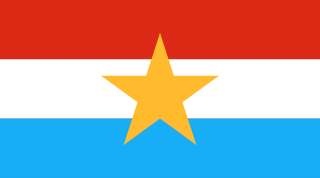Related Research Articles

The Tatmadaw or Sit-Tat is the military of Myanmar. It is administered by the Ministry of Defence and composed of the Myanmar Army, the Myanmar Navy and the Myanmar Air Force. Auxiliary services include the Myanmar Police Force, the Border Guard Forces, the Myanmar Coast Guard, and the People's Militia Units. Since independence in 1948, the Tatmadaw has faced significant ethnic insurgencies, especially in Chin, Kachin, Kayin, Kayah, and Shan states. General Ne Win took control of the country in a 1962 coup d'état, attempting to build an autarkic society called the Burmese Way to Socialism. Following the violent repression of nationwide protests in 1988, the military agreed to free elections in 1990, but ignored the resulting victory of the National League for Democracy and imprisoned its leader Aung San Suu Kyi. The 1990s also saw the escalation of the conflict involving Buddhists and Rohingya Muslims in Rakhine State due to RSO attacks on the Tatmadaw forces, which saw the Rohingya minority facing oppression and, starting in 2017, genocide.

Kokang is a region in Myanmar. It is located in the northern part of Shan State, with the Salween River to its west, and sharing a border with China's Yunnan Province to the east. Its total land area is around 1,895 square kilometers (732 sq mi). The capital is Laukkai. Kokang is mostly populated by Kokang Chinese, a Han Chinese group living in Myanmar.

The Kachin peoples, more precisely the Kachin Wunpong or simply Wunpong, are a confederation of ethnic groups who inhabit the Kachin Hills in Northern Myanmar's Kachin State and neighbouring Yunnan Province, China, as well as Arunachal Pradesh, Assam in Northeastern India. About 1.5 million Kachin peoples live in the region. The term Kachin people is often used interchangeably with the main subset, called the Jingpo people in China.

The Karen National Liberation Army Burmese: ကရင်အမျိုးသား လွတ်မြောက်ရေး တပ်မတော်; abbreviated KNLA) is the military branch of the Karen National Union (KNU), which campaigns for the self-determination of the Karen people of Myanmar. The KNLA has been fighting the Burmese government since 1960s as part of the Karen conflict, which has been ongoing since 1949.

Insurgencies have been ongoing in Myanmar since 1948, the year the country, then known as Burma, gained independence from the United Kingdom. The conflict has largely been ethnic-based, with several ethnic armed groups fighting Myanmar's armed forces, the Tatmadaw, for self-determination. Despite numerous ceasefires and the creation of autonomous self-administered zones in 2008, many armed groups continue to call for independence, increased autonomy, or the federalisation of the country. The conflict is the world's longest ongoing civil war, having spanned more than seven decades.
Ceasefires in Myanmar have been heavily utilized by the Burmese government as a policy to contain ethnic rebel groups and create tentative truces. The first ceasefire was arranged by the State Law and Order Restoration Council in 1989, specifically spearheaded by Khin Nyunt, then the Chief of Military Intelligence, with the Kokang-led National Democratic Alliance Army, which had recently split from the Communist Party of Burma due to internal conflicts.

The Arakan Army is an ethnic armed organisation based in Rakhine State (Arakan). Founded on 10 April 2009, the AA is the military wing of the United League of Arakan (ULA). It is currently led by Commander-in-Chief Major General Twan Mrat Naing and vice deputy commander-in-chief Brigadier General Nyo Twan Awng. The Arakan Army states that the objective of its armed revolution is to restore the sovereignty of the Arakan people. In a February 2024 interview, Twan Mrat Naing claimed that the AA had grown to at least 38,000 troops. Anthony Davis, an expert of military and security, rejected this claim and estimated that it has at least 15,000 troops in Chin State and Rakhine State, in addition to around 1500 in Kachin State and Shan State. In the early 2010s, the Arakan Army fought alongside the Kachin Independence Army (KIA) against the Tatmadaw in the Kachin conflict. Following the 2016 outbreak of conflict in Rakhine state, AA became more heavily involved in the Arakan region. In 2019, AA would launch attacks on state security forces and the Myanmar Army would respond heightening clashes. The AA reached a ceasefire in late 2020 after eroding the central government's control in northern Rakhine. The power vacuum would be filled by the AA over the next 18 months with state-building efforts, like their COVID-19 vaccine rollouts.

The Karen conflict is an armed conflict in Kayin State, Myanmar. It is part of the wider internal conflict in Myanmar between the military government and various minority groups. Karen nationalists have been fighting for an independent state, known as Kawthoolei, since 1949. The Karen National Union (KNU) and its Karen National Liberation Army (KNLA) are the most prominent Karen rebel groups. Hundreds of thousands of civilians have been displaced by the conflict, many of whom fled to neighbouring Thailand and survive in refugee camps.

The Mon National Liberation Army is a Mon insurgent group in Myanmar (Burma). It is the armed wing of the New Mon State Party (NMSP), and has been fighting government forces since 1949, though under different names. The NMSP signed the Nationwide Ceasefire Agreement (NCA) on 15 October 2015 with several other insurgent groups and the government of Myanmar.

Border Guard Forces are subdivisions of the Tatmadaw consisting of former insurgent groups in Myanmar under the instruction of Regional Military Commands. The government announced its plan to create Border Guard Forces in April 2009, in the hopes of ending hostilities between the government and insurgent groups leading up to the 2010 general election.
The Fall of Manerplaw occurred on 27 January 1995, when the village of Manerplaw was captured by the Tatmadaw and the Democratic Karen Buddhist Army (DKBA). Manerplaw was the headquarters of two armed opposition groups, the Karen National Union (KNU) and the All Burma Students' Democratic Front (ABSDF). The final military assault by the Tatmadaw, aided by positional information provided by the DKBA, was met with little resistance by the KNLA, whose leaders had ordered a tactical retreat.
Violent clashes have been ongoing in the northern part of Myanmar's Rakhine State since October 2016. Insurgent attacks by the Arakan Rohingya Salvation Army (ARSA) have led to sectarian violence perpetrated by Myanmar's military and the local Buddhist population against predominantly Muslim Rohingya civilians. The conflict has sparked international outcry and was described as an ethnic cleansing by the United Nations High Commissioner for Human Rights. In August 2017, the situation worsened and hundreds of thousands of refugees fled Myanmar into Bangladesh, with an estimated 500,000 refugees having arrived by 27 September 2017. In January 2019, Arakan Army insurgents raided border police posts in Buthidaung Township, joining the conflict and beginning their military campaign in northern Rakhine State against the Burmese military.

The People's Defence Force is the armed wing of the National Unity Government (NUG) in Myanmar. The armed wing was formed by the NUG from youths and pro-democracy activists on 5 May 2021 in response to the coup d'état that occurred on 1 February 2021 that put the military junta and their armed wing the Tatmadaw in power. The military junta designated it as a terrorist organisation on 8 May 2021. In October 2021, NUG's Ministry of Defence announced that it had formed a central committee to coordinate military operations across the country.

The Myanmar civil war, also called the Myanmar Spring Revolution or People's Defensive War, is an ongoing civil war following Myanmar's long-running insurgencies, which escalated significantly in response to the 2021 military coup d'état and the subsequent violent crackdown on anti-coup protests. As of February 2024, thousands of soldiers have surrendered without a fight, including six generals of the Tatmadaw, the regime’s military. A group of observers writes that the Tatmadaw's forces remain "formidable and well-equipped", with "external allies and economic resources".
The following is a timeline of major events during the Myanmar civil war (2021–present), following the 2021 military coup d'état and protests. It was also a renewed intensity in existing internal conflict in Myanmar.
Lieutenant General Nyunt Win Swe is a Burmese military officer and current commander of Myanmar's Yangon Command.
Brigadier General Tin Soe is a Burmese military officer. From 2019 to 2021, he served as the military attaché for the Myanmar embassy in Tokyo, Japan. Following the 2021 Myanmar coup d'etat, he returned to Myanmar and was promoted to the rank of brigadier general. From August 2021 to July 2022, he was deployed to the Eastern Command headquarters in Taunggyi, Shan State. In December 2021, troops from the Eastern Command committed the Mo So massacre, which killed 44 civilians. In August 2022, Human Rights Watch reported that Tin Soe trained at the Joint Staff College, which is run by the Ministry of Defense (Japan). In September 2022, the Japanese government announced it was suspending training programs for the Burmese military starting in 2023.
The Pinlaung massacre was a mass killing of civilians by Burmese military forces on 11 March 2023, in the village of Namneng, Shan State. During the massacre, Myanmar Army troops killed at least 30 civilians, including 3 Buddhist monks. The massacre occurred 9 days after the Tar Taing massacre in Sagaing.
The Mon Taing Pin massacre was a mass killing of civilians by Burmese military forces on 11 May 2022, in the village of Mondaingbin, Sagaing Region, Myanmar. During the massacre, Myanmar Army troops executed at least 37 villagers. Sagaing Region later became the site of several additional mass killings perpetrated by the Burmese military, including the Letyetkon and Tadaing massacres.
The military of Myanmar (Tatmadaw) and its allies have committed numerous war crimes and crimes against humanity during the 2021–present Myanmar civil war.
References
- ↑ "What is the Myanmar military's 'four cuts' strategy?".
- ↑ "Military's 'four cuts' doctrine drives perpetual human rights crisis in Myanmar, says UN report" (Press release). Office of the United Nations High Commissioner for Human Rights. 3 March 2023.
- ↑ Nai Aue Mon; Quadrini, Maggi (2023-12-05). "Return of the 'four cuts' in Myanmar's Mon state" . Retrieved 2024-02-09.
- ↑ "Locals Fear 'Four Cuts' in Kachin State - Myanmar". ReliefWeb. 2011-05-20. Retrieved 2024-02-09.